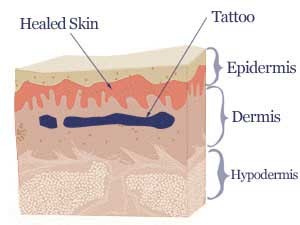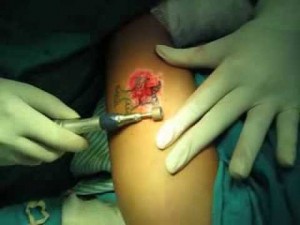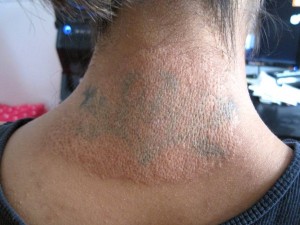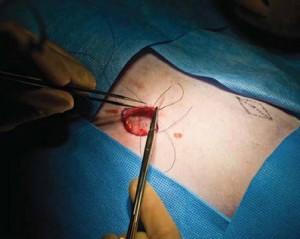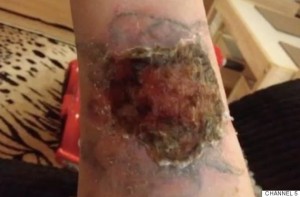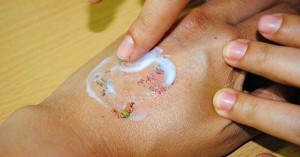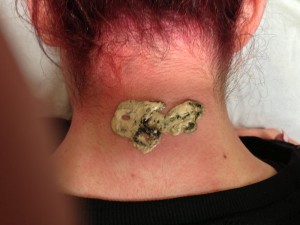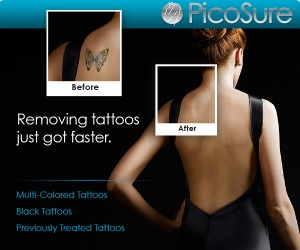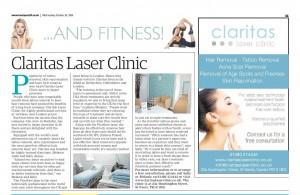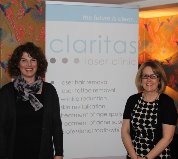Lifting of Restrictions and Your Appointment
July 15th, 2021
July 14th 2021
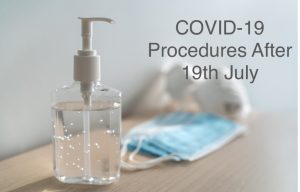
- Following the recent government announcement regarding the lifting of restrictions, we have decided to maintain our current procedures in order to protect our staff and clients. These will remain in place until further notice.
- All forms will continue to be sent via email for submission back to us before your appointment. This will include a COVID-19 pre-appointment screen to be submitted the day before your appointment.
- Social distancing will remain, where possible.
- We ask that you wear a mask, please (unless exempt) and sanitise your hands on arrival at the clinic.
- Once again, we appreciate your understanding.
COVID-19 Guidelines: New Procedure for Appointments
July 15th, 2020

- New clients will complete and submit their medical forms back to us online prior to attending the clinic. Consent forms will be handled similarly as we are keeping the clinic paper-free, as far as possible
- You will be emailed the day before your appointment and will need to confirm you are well by completing a short COVID-19 screening questionnaire and confirm your consent- these will be submitted back to us online.
- Please attend your appointment UNACCOMPANIED.
- You can be sent a secure link to pay for your treatment with your card on-line prior to your treatment. Please choose this option wherever possible or be ready to use CONTACTLESS Apple Pay in the clinic. There will however still be the option to pay at the clinic with exact cash or by card using our card machine.
- Please enter the clinic at the time of your appointment. Please DO NOT arrive early. If you are more than 5 minutes late, please wait outside and call the clinic before entering.
- On arrival, you will be asked to use a hand sanitiser & be provided with a face mask (if you don’t already have one) to wear for the duration of your appointment.
- We appreciate your understanding in us keeping your time in the clinic as short as necessary
Book your free video consultation now!
May 22nd, 2020

Get a video consultation booked today; no need to wait until the clinic is open…
Hopefully won’t be too long now until we can open up the clinic and start seeing clients again. We can’t wait! If you’re really keen to find out more about our PicoSure laser treatments for tattoos and skin, or know more about Soprano Ice laser hair removal, we would love to talk to you now! You’ll be able to ask us lots of questions and we can give you plenty of information about your treatment. Once we’re up and running again (and after a quick patch test…), you’ll be ready to get going on your treatment in no time at all!
Simply book an appointment online today via the browser tab, send an email to info@claritaslaserclinic.co.uk, message us through Instagram #claritaslaser, through Facebook…or call us now on 01480 214442.
We look forward to ‘seeing’ you soon!
Laser Tattoo Removal during the Covid-19 Lockdown
March 24th, 2020
 ‘Help! I can’t attend my next laser session on my tattoo because of lockdown.’
‘Help! I can’t attend my next laser session on my tattoo because of lockdown.’
If like many others, you are feeling disappointed about this, we understand. It’s frustrating to have what is already a slow process drawn out even further. But be reassured that once the laser treatment course has commenced, your body will continue to gradually clear the lasered ink, even if you are overdue for your next session.
By helping your immune system operate more efficiently, you’ll not only help fade your tattoo faster, you’ll also be in better health should you become exposed to coronavirus.
Here are some things that you can do to help the process and ensure you are ready to resume laser treatment once the clinic re-opens:
1. Get Active
Exercise increases blood flow to your skin and all around your body, which helps move the lasered ink particles away from your skin faster. The government is encouraging us to exercise once a day during lockdown for our physical and mental well-being.
2. Stay Hydrated
Increasing your water intake can greatly impact how quickly your treatments work. Decreasing alcohol consumption will also be beneficial to your treatments because of alcohol’s dehydrating effect on the body. Staying well hydrated makes it easier for your body to process the ink, therefore your tattoo will fade faster. Two litres/day is ideal, though you should increase this if exercising intensely.
3. Eat Healthily
Food is more than fuel; the human body requires vitamins and minerals, proteins, carbohydrates & fats to keep the body functioning at its best. Try to avoid an unbalanced diet or one with a lot of processed food. Aim instead for a whole-food diet, mostly plant-based with colourful foods you prepare from scratch. But of course, it’s OK to enjoy an occasional less-healthy treat!
4. Get Enough Sleep
There’s no excuse not to get enough sleep while pubs, clubs and socialising is off-limits. Sleep is a well-documented means of strengthening the body and immune system – it’s when we recover both mentally and physically from the day. Adults need 7-8 hours’ sleep per night.
5. Quit Smoking
Of course, this is easier said than done, but regular smoking significantly decreases the effectiveness of your laser treatments. If your immune system is already working to remove smoking pollutants, it can’t work so well on your ink. If quitting is not an option for you, try to cut back on smoking to get the most out of your treatments. Making the commitment to tattoo removal can be a great motivator to reduce or quit smoking.
6. Avoid the Sun
If you get sun exposure to the treatment area, you’ll need to wait four weeks before you can have your next laser session. So use sunscreen, dressings or clothing to cover your tattoo as we head into Spring. Avoiding a tan in the treatment area will also reduce the chance of laser-induced pigmentation changes.
Picosure’s laser tattoo removal technology is the most effective currently available and looking after yourself day-to-day can speed up the tattoo removal process.
Although Claritas Laser Clinic is currently closed during the Covid-19 outbreak, our clinicians are still available to answer any questions you may have about laser tattoo removal. Feel free to email or call us for more information!
Call the clinic on 01480 214442 or email us at info@claritaslaserclinic.co.uk
Laser hair removal – where to start and getting it right!
February 21st, 2020
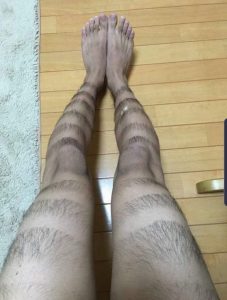
Are you fed up of constantly shaving or having to let your hair grow long before waxing? Well, laser hair removal is the answer!
There are lots of hair removal lasers out there and it can be really confusing which one to choose. Here at Claritas Laser Clinic we have Soprano Ice which has the perfect and only wavelength to target and reduce your hair. Soprano Ice has an icy cold tip to keep you nice and comfortable whilst we zap away those hairs! As well as having one of the best lasers for hair removal at Claritas, you will also be treated by one of our medically qualified practitioners. Rest assured that you will be in safe hands.
Typically, we recommend that you come every 4 – 6 weeks for the first 8 treatments to achieve a great result, but this can vary from client to client. With all laser hair removal systems, top ups may be required to maintain those smooth legs…… we are sure though that you will be thrilled with the results that Soprano Ice can deliver!
If you’ve been thinking about laser hair removal and a hair-free summer, then talk to us now and book in for a free consultation. We can talk you through the process from start to finish, then you will know exactly what to expect.
Call the clinic on 01480 214442 or book online at http://www.claritaslaserclinic.co.uk/bookonline
Tattoo removal – does it hurt? We tell it like it is
June 11th, 2019
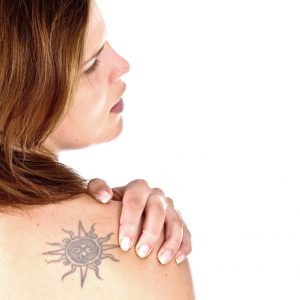 Having a tattoo can be exciting and brings a connection with the image that’s now a part of your skin. But… at some point, you just might regret this decision and wish you could make it go away.
Having a tattoo can be exciting and brings a connection with the image that’s now a part of your skin. But… at some point, you just might regret this decision and wish you could make it go away.
Perhaps you’ve changed how you feel about your tattoo. Or maybe the subject is no longer relevant. Or it’s just that the artwork was never quite right.
If this is you, you are not alone! Almost 1 in 5 people are unhappy with at least one of their tattoos.
You can do something about that tattoo though so don’t despair.
If you’ve done your research, you’ll realise that the best way to remove it without the risk of permanent scarring is with laser treatment.
For many, it is the fear of the pain. So allow us to share some experienced reassurance…
There is no getting away from the fact that some pain is involved with tattoo removal. As technology has advanced, laser treatment has become much more tolerable and many of our clients liken the sensation to when their tattoo was first done. The BIG difference is that it is so much faster! Clients who have been treated with older lasers, for instance Q-switched, and then PicoSure notice the positive difference with this contemporary technology.
For example, a small tattoo of 3cm square would take about a minute to treat.
Throughout the process an ultra-cold air jet cools and numbs the skin. This counteracts the heat of the laser and helps protect the skin whilst the laser targets the ink. Contrary to some people’s mistaken belief, the tattoo is not ‘burned off’.
If even a minute of pain seems unbearable, or your tattoo is larger, then there are numbing creams that can be applied to the skin 30 minutes before treatment – these reduce rather than eliminate discomfort. Alternatively, for complete pain elimination, you can have injections of local anaesthetic. We are fully trained in all of this.
Hopefully, this has helped to calm any concerns you have but the best reassurance will come from talking through your situation with one of our team here at Claritas Laser Clinic. We are experienced, professional and kind and, importantly, understand how you might be feeling and quickly put you at ease.
Your first consultation is free so you can see how clinic, see how we work and then make your decision.
Call 01480 214442 for a free consultation or book on-line here and take that step today.
Delighted after just two treatments!
May 21st, 2019
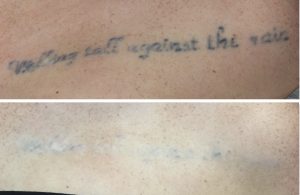
“Much less painful than I thought.” Ashleigh is happy!
May 11th, 2019
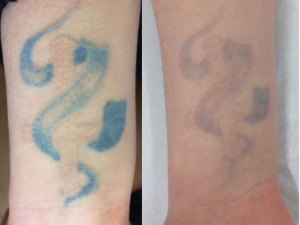
Ashleigh has had many treatments at other clinics but after just ONE Picosure treatment, her ink has finally started to disappear. She says, “It wasn’t half as painful and much faster than previous laser treatments.”
You know where to come to when you want to make that change.
Why not book online to arrange your consultation now?
Clover be gone!
May 9th, 2019
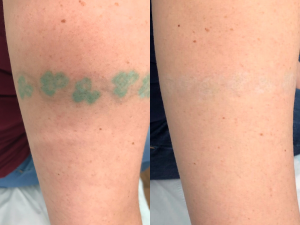
Never lose ‘Faith’. Unless you want to!
May 7th, 2019

Faith just had to go for our client and look at the results after just four treatments with Picosure.
Nearly there. Impressive eh!
Age spots and pigment marks? Help is right here
April 25th, 2019
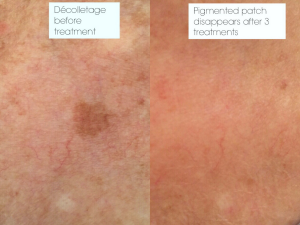 Are you self-conscious about age spots and brown marks caused by sun damage? Are they adding years to your appearance? Then laser treatment could be the solution.
Are you self-conscious about age spots and brown marks caused by sun damage? Are they adding years to your appearance? Then laser treatment could be the solution.
Don’t just take our word for it. Take Pat’s word for it…
Pat, at 70 years young, had stopped wearing scoop-necked tops due to the unsightly pigmented area on her décolletage (shown here).
After just three treatments with our PicoSure laser, each taking just a few minutes, the lesion had completely disappeared.
‘Lightening creams’ can waste your time and, more importantly, your money. Instead come and have a chat with us to discuss whether laser treatment could be a much more effective treatment for your age spots or other pigmentation problems. We can treat the face and hands as well as the body.
Make the most of our clinical knowledge to assess pigmentation changes from a medical as well as an aesthetic perspective. We will make a diagnosis and make sure you receive the correct management and treatment with a friendly welcome.
Book online for a free consultation.
Support your skin and look and feel wonderful
April 21st, 2019

Spring is well and truly here and summer is right around the corner. It’s the time of growth and new life but even Mother Nature enjoys a bit of rejuvenation and as we age, we need a bit of support too.
How? We use pulses of laser light that reach deeply into the skin. Then the body’s natural healing process sweeps away older, damaged tissue and rebuilds it with fresh, new collagen and elastin—the crucial building blocks of smooth, youthful skin. Presto! You’re rejuvenated.
Forget the Easter eggs, choose a ‘healthy’ voucher
April 5th, 2019

Easter will be here in two weeks with Good Friday on 19th April. So rather than that chocolatey Easter egg, treat someone to a voucher from us. Healthier and longer lasting!
You can buy gift vouchers over the phone by calling 01480 214442 and we will post them to any UK postcode FREE of charge.
Unsure what to buy? Call or email us and we’ll happily advise you so you get it just right.
Ingrowing hairs giving you problems? Get rid of them right here
March 14th, 2019
If you are one of the unlucky ones who develop ingrown hairs, life can be pretty miserable.
The skin around these hairs can swell to the size of a hazelnut and there’s often redness and tenderness, which can be really painful never mind unsightly.
However, help is at hand as laser treatment is recommended by dermatologists as the best way to prevent ingrown hairs.

Ingrown and normal hair
So why do we get ingrown hairs? It happens when a new hair curls in on itself as it grows and the hair becomes trapped in the follicle. Cutting or shaving the hair too closely makes it easier for the sharpened end of the hair to pierce the skin and grow inwards.
Inflammation causes redness and localised swelling and, if infection sets in, then a pus-filled cyst can develop. Infection is usually due to staphylococcal bacteria entering the follicle and both shaving and waxing can be the causes.
Where do they most frequently occur? Ingrown hairs are most common in areas where hair is coarse or curly or with frequent shaving; in men, on their chin and neck (causing razor or shaving bumps) and on their backs and in women, in the pubic area, along the bikini line or the underarms.
If you’re prone to this, then Laser Treatment is the hair removal method of choice as the laser energy targets the hair follicle to prevent new hair growth.
Talk to us for free friendly advice!
Jeremy ‘fades to grey’ – then gone
February 6th, 2019
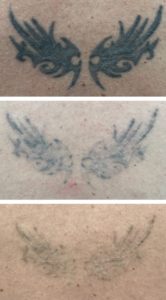
Jeremy came in wanting to fade a tattoo on his back as he was planning a new piece of artwork to go in its place.
Here are the photos of it before and after just TWO sessions.
He’ll need to let the skin rest for a few weeks and then he’ll be ready to go! Job done.
Looking for similar? Talk to us and we can advise and lead you through the whole procedure.
Tattoo removal methods revealed
January 17th, 2019
How to remove a tattoo and why laser tattoo removal is best
Many of us are having tattoos now, in fact almost a third of people have a tattoo by the age of 18. Sadly though, one in six people in the UK will regret having it done. A third of those with tattoos worry that they will look awful as they get older. And half of those people admit that the tattoo could hold them back in their careers.
So what can be done?
There are many options available for tattoo removal. Unfortunately though some of these techniques are not safe at all and can cause permanent scarring. It’s important when considering tattoo removal to know exactly where in your skin the tattoo exists. The diagram below of skin shows the tattoo particles lying underneath the healthy outer epidermis. So tattoo removal needs to be effective without damaging the outer layer of your skin.
Some of the different methods of tattoo removal available today.
Tip: Keep reading right to the bottom…
1. Micro dermabrasion
Micro dermabrasion involves using an abrasive device to sand down the layers of the skin. This will be incredibly painful and will result in an open wound that will have to heal. There are obviously going to be many complications of such a treatment which include pain, infection, burning, itching, scabbing, scarring, bleeding and many more.
2. Salabrasion
Salabrasion is similar to microdermabrasion, but instead of using an abrasive brush or a diamond wheel, granular salt and water are used. These are blasted onto the skin with force, resulting in the stripping away of the outer layers of the skin. This technique is repeated every few days until the scarred tissue pulls away supposedly leaving healthy tissue underneath taking the tattoo with it. Yet again there are many negative side effects of this treatment and ultimately will result in very bad scarring.
3. Surgical excision
Surgical excision of a tattoo involves using a surgical knife to cut away the tattoo. This will performed under local anaesthetic injections. It can only be done if the skin can compensate for the area where the tattoo has been removed – this means can the skin be repaired? Large tattoos will require skin grafts and need multiple visits if the skin cannot be simply stitched together. The after effects of surgical excision include pain, swelling, bruising, postoperative infection and bruising.
4. Acid
Acid contained within certain lotions and creams can be applied to the tattooed skin to remove the ink. Unfortunately, it is not as simple as that. The ink particles of the tattoo sit within the mid layer of the skin, and so the acid has to burn off the outer layer of the skin before even reaching the ink. According to clinical dermatologists in the UK, anything that burns off the skin just wont work and will lead to many more complications. Many products bought over the internet contain trichloroacetic acid which is a corrosive chemical, and is actually a banned ingredient resulting in horrific burns.
5. Tattoo removal creams
Similar again to acid removal, these creams will contain corrosive substances that will claim to fade your tattoo. As the ink lies in the middle layer of the skin, such creams will never be able to reach the tattoo pigment and will only likely result in irritated and inflamed skin that could actually result in scarring.
6. Rejuvi and other injectable methods
Rejuvi involves having a chemical remover applied to the skin, similar to having a tattoo in the first instance. Rejuvi claims to ‘capture’ the ink particles by forming a thicker substance within the dermis and then pushing out through the outer layer of the skin along with the trapped ink particles. It all sounds very simple, but sadly it is not and has resulted in really severe scarring.
7. Cryotherapy
Cryotherapy involves in having the tattooed skin frozen off. Yet again though, this involves taking away the healthy unaffected outer layer of skin to reach the pigmented dermal layer. Sometimes cryotherapy can be combined with microdermasion, so the results of such treatment not surprisingly result in really bad scarring, severe pain, swelling, blistering and scabbing. post operative infection is highly likely.
And last but by no means least – laser tattoo removal.
The safest and most effective method for tattoo removal available today.
8. Laser Tattoo Removal
Laser tattoo removal is the only safe and effective method to remove a tattoo without damaging the outer layer of the skin. Laser light energy penetrates the skin to reach the tattoo pigments. Different wavelengths of light will target different tattoo colours. The amount of energy delivered must be sufficient to break up the ink. Older lasers would do this in nanoseconds, and the resultant heat will fragment the heat. Too much heat will result in damage to the surrounding skin. Fortunately today we have Picosure and it’s world leading picosecond technology. The pulse duration, ie the speed, is so fast it breaks up the ink photo-mechanically rather than heating the ink. The integrity of the outer dermis of the skin is maintained and undamaged.
Call us today and let’s talk it through with you. 01480 214442
Just look at these results after just six PicoSure treatments!
January 11th, 2019
The proof, they say, is in the pudding! Or in this case, the reveal of an arm with little trace of a tattoo.

And we are so pleased with the progress so far.
After only six Picosure treatments this, what was a large tattoo, is almost gone.
Discover more about our laser tattoo removal here.
In-growing hairs? Not nice so be rid of them!
December 3rd, 2018
If you are one of the unlucky few who develop in-grown hairs, life can be pretty miserable.
The skin around these hairs can swell to the size of a hazelnut and there’s often redness and tenderness, which can be really painful, never mind unsightly!
However, help is at hand as laser treatment is recommended by dermatologists as the best way to prevent ingrown hairs.

Ingrown and normal hair
So why do we get in-grown hairs? It happens when a new hair curls in on itself as it grows and the hair becomes trapped in the follicle. Cutting or shaving the hair too closely makes it easier for the sharpened end of the hair to pierce the skin and grow inwards.
Inflammation causes redness and localised swelling and, if infection sets in, then a pus-filled cyst can develop. Infection is usually due to staphylococcal bacteria entering the follicle and both shaving and waxing can be the causes.
Where do they most frequently occur? In-grown hairs are most common in areas where hair is coarse or curly or with frequent shaving; in men, on their chin and neck (causing razor or shaving bumps) and on their backs and in women, in the pubic area, along the bikini line or the underarms.
If you’re prone to this, then Laser Treatment is the hair removal method of choice as the laser energy targets the hair follicle to prevent new hair growth.
Talk to us for free friendly advice!
Best tattoo removal methods revealed
November 13th, 2018
How to remove a tattoo and why laser tattoo removal is best
Many of us are having tattoos now, in fact almost a third of people have a tattoo by the age of 18. Sadly though, one in six people in the UK will regret having it done. A third of those with tattoos worry that they will look awful as they get older. And half of those people admit that the tattoo could hold them back in their careers.
So what can be done?
There are many options available for tattoo removal. Unfortunately though some of these techniques are not safe at all and can cause permanent scarring. It’s important when considering tattoo removal to know exactly where in your skin the tattoo exists. The diagram below of skin shows the tattoo particles lying underneath the healthy outer epidermis. So tattoo removal needs to be effective without damaging the outer layer of your skin.
Some of the different methods of tattoo removal available today.
Tip: Keep reading right to the bottom…
1. Micro dermabrasion
Micro dermabrasion involves using an abrasive device to sand down the layers of the skin. This will be incredibly painful and will result in an open wound that will have to heal. There are obviously going to be many complications of such a treatment which include pain, infection, burning, itching, scabbing, scarring, bleeding and many more.
2. Salabrasion
Salabrasion is similar to microdermabrasion, but instead of using an abrasive brush or a diamond wheel, granular salt and water are used. These are blasted onto the skin with force, resulting in the stripping away of the outer layers of the skin. This technique is repeated every few days until the scarred tissue pulls away supposedly leaving healthy tissue underneath taking the tattoo with it. Yet again there are many negative side effects of this treatment and ultimately will result in very bad scarring.
3. Surgical excision
Surgical excision of a tattoo involves using a surgical knife to cut away the tattoo. This will performed under local anaesthetic injections. It can only be done if the skin can compensate for the area where the tattoo has been removed – this means can the skin be repaired? Large tattoos will require skin grafts and need multiple visits if the skin cannot be simply stitched together. The after effects of surgical excision include pain, swelling, bruising, postoperative infection and bruising.
4. Acid
Acid contained within certain lotions and creams can be applied to the tattooed skin to remove the ink. Unfortunately, it is not as simple as that. The ink particles of the tattoo sit within the mid layer of the skin, and so the acid has to burn off the outer layer of the skin before even reaching the ink. According to clinical dermatologists in the UK, anything that burns off the skin just wont work and will lead to many more complications. Many products bought over the internet contain trichloroacetic acid which is a corrosive chemical, and is actually a banned ingredient resulting in horrific burns.
5. Tattoo removal creams
Similar again to acid removal, these creams will contain corrosive substances that will claim to fade your tattoo. As the ink lies in the middle layer of the skin, such creams will never be able to reach the tattoo pigment and will only likely result in irritated and inflamed skin that could actually result in scarring.
6. Rejuvi and other injectable methods
Rejuvi involves having a chemical remover applied to the skin, similar to having a tattoo in the first instance. Rejuvi claims to ‘capture’ the ink particles by forming a thicker substance within the dermis and then pushing out through the outer layer of the skin along with the trapped ink particles. It all sounds very simple, but sadly it is not and has resulted in really severe scarring.
7. Cryotherapy
Cryotherapy involves in having the tattooed skin frozen off. Yet again though, this involves taking away the healthy unaffected outer layer of skin to reach the pigmented dermal layer. Sometimes cryotherapy can be combined with microdermasion, so the results of such treatment not surprisingly result in really bad scarring, severe pain, swelling, blistering and scabbing. post operative infection is highly likely.
And last but by no means least – laser tattoo removal.
The safest and most effective method for tattoo removal available today.
8.Laser Tattoo Removal
Laser tattoo removal is the only safe and effective method to remove a tattoo without damaging the outer layer of the skin. Laser light energy penetrates the skin to reach the tattoo pigments. Different wavelengths of light will target different tattoo colours. The amount of energy delivered must be sufficient to break up the ink. Older lasers would do this in nanoseconds, and the resultant heat will fragment the heat. Too much heat will result in damage to the surrounding skin. Fortunately today we have Picosure and it’s world leading picosecond technology. The pulse duration, ie the speed, is so fast it breaks up the ink photo-mechanically rather than heating the ink. The integrity of the outer dermis of the skin is maintained and undamaged.
Look after your skin this Autumn
October 25th, 2018
Sometimes Mother Nature needs a bit of a helping hand when it comes to giving your skin a helping hand. It happends naturally to us all and as we age and our skin loses its youthful tones and elasticity.
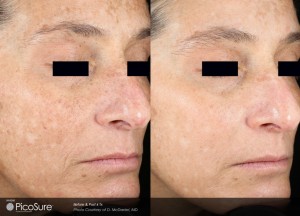
Help is right here though.
By using pulses of laser light that reach deeply into the skin, the body’s natural healing process sweeps away older, damaged tissue and rebuilds it with fresh, new collagen and elastin- the crucial building blocks for smooth, youthful skin. Magic! (well not really, we know it’s all about the science). You’re rejuvenated.
Book for your free consultation and we’ll explain how a rejuvenated look can be yours.
Discover more here or contact us today.
Get ready for Christmas! Your vouchers await
October 18th, 2018
Now you can treat someone special to any treatment and make a happy difference to their day. Perfect for Christmas surprises!
Y ou can buy Claritas gift vouchers in any denomination from our Clinic at 23a Huntingdon Street, St Neots, Cambridgeshire, PE19 1BG.
ou can buy Claritas gift vouchers in any denomination from our Clinic at 23a Huntingdon Street, St Neots, Cambridgeshire, PE19 1BG.
OR
You can buy gift vouchers over the phone by calling 01480 214442 and we will post them to any UK postcode FREE of charge.
OR
Unsure what to buy? Call or email us and we’ll happily advise you so you get it just right.
New clinic offers anti-wrinkle injections, dermal fillers and more
August 30th, 2018
Introducing Facial Aesthetics by Dr Steph France BDS | Awaken Clinic
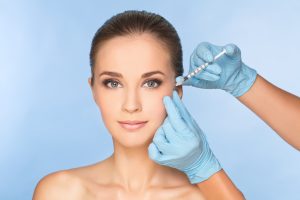
Anti-wrinkle injections | Dermal fillers | Hyperhidrosis or excessive underarm sweating
We are delighted to welcome Dr Steph France BDS offering non-surgical facial aesthetics, dermal fillers and hyperhidrosis at Awaken Clinic, based at our clinic in St Neots.
Steph has been a qualified dentist for almost 30 years and has considerable knowledge of the facial anatomy. This gives her a unique advantage in assessing the balance and overall aesthetics of the face. Having trained at the world-renowned BK institutem she is a member of the IAAFA (International Academy of Advanced Facial Aesthetics).
Awaken Clinic is now open here at Claritas and offers a range of treatments including anti-wrinkle injections.
Ingrowing hairs? Here’s how to be rid of them
August 9th, 2018
If you develop ingrown hairs, life can be pretty miserable.
The skin around these hairs can swell to the size of a hazelnut and there’s often redness and tenderness, which can be really painful, never mind unsightly. However, help is at hand as laser treatment is recommended by dermatologists as the best way to prevent ingrown hairs.

Why do we get ingrown hairs?
It happens when a new hair curls in on itself as it grows and the hair becomes trapped in the follicle. Cutting or shaving the hair too closely makes it easier for the sharpened end of the hair to pierce the skin and grow inwards.
Inflammation causes redness and localised swelling and, if infection sets in, then a pus-filled cyst can develop. Infection is usually due to staphylococcal bacteria entering the follicle and both shaving and waxing can be the causes.
Where do they most frequently occur?
Ingrown hairs are most common in areas where hair is coarse or curly or with frequent shaving; in men, on their chin and neck (causing razor or shaving bumps) and on their backs and in women, in the pubic area, along the bikini line or the underarms.
If you’re prone to this, then Laser Treatment is the hair removal method of choice as the laser energy targets the hair follicle to prevent new hair growth.
Talk to us for free friendly advice!
Oh my it’s sunny! But how does it affect laser treatment?
July 8th, 2018
Summer is well and truly here right now. It’s also a popular time to travel abroad and enjoy a hot sunny holiday.
But did you know that UVA and UVB rays in sunlight and the rays emitted by the laser are all light energy within the electromagnetic spectrum.
So what is the affect of sun exposure if you are planning laser tattoo treatment or are mid-way through a treatment course? Read on…
Laser Tattoo Removal
It’s really important to keep any sun exposure to your tattoo to the ABSOLUTE minimum. If at all possible cover the tattoo with a dressing – easier if the tattoo is only small. If it’s larger you may have to choose to wear clothing that covers the tattoo during the day. If your tattoo is too large to cover and you plan to be on the beach or by the poolside, then regular application of a waterproof sunblock of SPF 50 is recommended.
When the UV rays hit the skin, the production of melanin pigment is stimulated and this is what turns the skin brown. When the PicoSure laser is used to remove a tattoo, the ink should be the target and not the melanin pigment in your skin. If you are tanned, your laser treatment will be less effective at removing the tattoo. In addition, there is an increased risk of burning and blistering after treatment and also long term changes in the level of pigmentation in the treated skin.
Our team takes safety very seriously. If you have exposed your tattoo to the sun, we will not be able to perform a laser tattoo removal treatment for four weeks. We would also recommend that you wait for four weeks after a treatment before going in the sun. This means that if you are mid-way through a course of laser tattoo removal you need to give careful consideration to how you are going to COMPLETELY AVOID sun exposure this summer.
Trust us, it will be worth the effort and there will be so many summers in the future for you to enjoy without your unwanted tattoo!
Smooth legs anyone?
June 21st, 2018
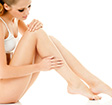 You could have smooth legs and smooth underarms so you can relax and enjoy those days without hair!
You could have smooth legs and smooth underarms so you can relax and enjoy those days without hair!
Start your laser treatment now and look forward to a permanent reduction in hair growth. Waxing, epilating and hair removal creams are a no-no once you start the process, although shaving is absolutely fine and is indeed recommended the day before a laser session.
You typically have eight sessions initially and are seen once every four to six weeks.
Age spots and pigmented marks? We can help!
June 11th, 2018
Are you self-conscious about age spots and brown marks caused by sun damage? Are they adding years to your appearance? Then laser treatment could be the solution.
Don’t just take our word for it. Take Pat’s word for it…
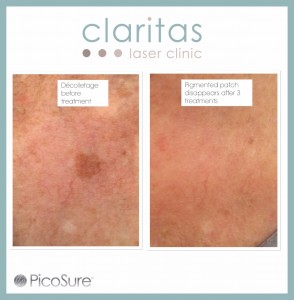
Pat, at 70 years young, had stopped wearing scoop-necked tops due to the unsightly pigmented area on her décolletage (shown here).
After just three treatments with our PicoSure laser, each taking just a few minutes, the lesion had completely disappeared.
‘Lightening creams’ can waste your time and, more importantly, your money. Instead come and have a chat with us to discuss whether laser treatment could be a much more effective treatment for your age spots or other pigmentation problems. We can treat the face and hands as well as the body.
Make the most of our clinical knowledge to assess pigmentation changes from a medical as well as an aesthetic perspective. We will make a diagnosis and make sure you receive the correct management and treatment with a friendly welcome.
Call us today on 01480 21442 or email us on info@claritaslaserclinic.co.uk
When it pays to persevere!
March 16th, 2018
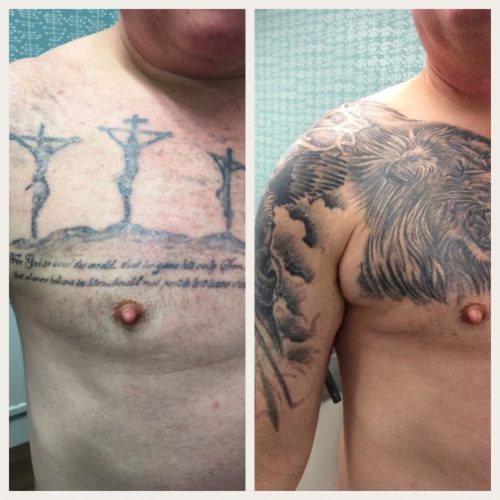 For many years, Simon has tried various treatments to reduce the tattoo on his arm with little effect as well as some scarring, much investment and a fair amount of discomfort.
For many years, Simon has tried various treatments to reduce the tattoo on his arm with little effect as well as some scarring, much investment and a fair amount of discomfort.
Thankfully, he came to us at Claritas and we treated Simon’s tattoos in sections to maximise clearance using our PicoSure to break up the ink where other lasers had failed. He is now finally delighted with the result.
“I’m so pleased with my fresh new cover-up (by Fabio’s in Cambridge) after the fine treatment at Claritas. I can now look forward to the summer with no worries about ‘covering up’ my old tattoo again,” said a smiling Simon.
We certainly think Simon’s new tattoo looks amazing!
How we banished Hannah’s ‘tattoo’ anxiety
February 28th, 2018
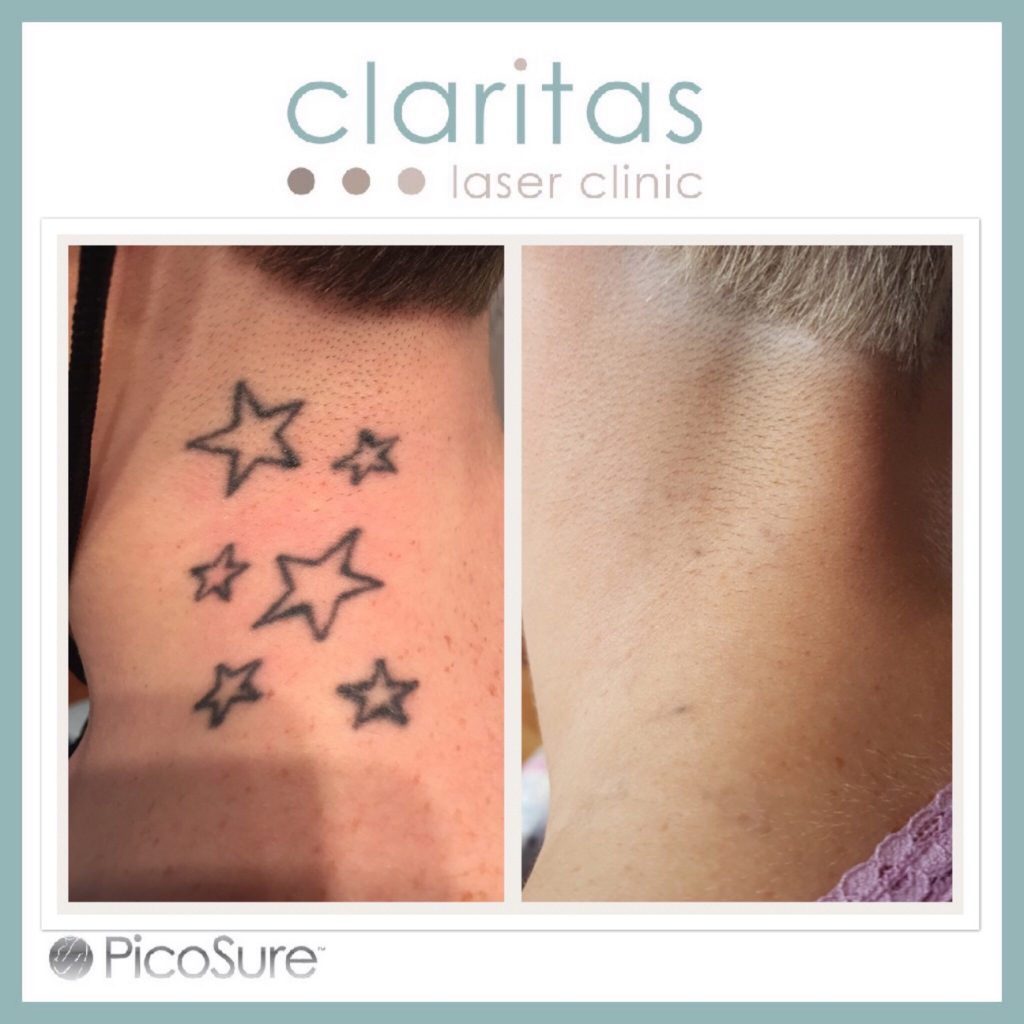 Hannah from Bengeo came to us recently as she wanted to have her stars tattoo removed. From the start, she said how anxious she was about the procedure but we soon put her at ease and this is what she shared with us:
Hannah from Bengeo came to us recently as she wanted to have her stars tattoo removed. From the start, she said how anxious she was about the procedure but we soon put her at ease and this is what she shared with us:
“I was anxious to have tattoo removal as I was unsure of what to expect. The ladies at Claritas, however, were so friendly and professional that I felt confident about the whole process. The results have been absolutely amazing. I would 100% recommend Claritas to anyone!”
Thanks Hannah; we’re delighted you’re happy with the result but more so that you felt relaxed and confident with us. Enjoy the stars, but just the ones in the night sky!
Forget the Easter eggs, choose a ‘healthy’ voucher!
February 19th, 2018
Easter arrives rather early this year! Good Friday is 30th March. So rather than that chocolatey Easter egg, treat someone to a voucher from us. Healthier and longer lasting!
Y ou can buy Claritas gift vouchers in any denomination from our Clinic at 23a Huntingdon Street, St Neots, Cambridgeshire, PE19 1BG.
ou can buy Claritas gift vouchers in any denomination from our Clinic at 23a Huntingdon Street, St Neots, Cambridgeshire, PE19 1BG.
OR
You can buy gift vouchers over the phone by calling 01480 214442 and we will post them to any UK postcode FREE of charge.
OR
Unsure what to buy? Call or email us and we’ll happily advise you so you get it just right.
Ingrown hairs proving prickly?
January 26th, 2018
Are you prone to ingrown hairs? If you’re one of the unlucky few who develop ingrown hairs, life can be really pretty prickly and painful.
The skin around these hairs can swell to the size of a hazelnut often with redness and even pus – all of which can be intensely painful, never mind unsightly!
But did you know, laser treatment is recommended by dermatologists as the best way to prevent ingrown hairs.

Ingrown and normal hair
So what causes ingrown hairs? They happen when a new hair curls in on itself as it grows and becomes trapped in the follicle. Cutting or shaving the hair too closely makes it easier for the sharpened end of the hair to pierce the skin and grow inwards.
Inflammation causes redness and localised swelling and, if infection sets in, then a pus-filled cyst can develop. Infection is usually due to staphylococcal bacteria entering the follicle and both shaving and waxing facilitate this.
Where do they most frequently occur? They are most common in areas where hair is coarse or curly or where frequent shaving occurs; in men, on their chin and neck (causing razor or shaving bumps) and on their backs and in women, in the pubic area, along the bikini line or the underarms.
If you’re prone to this, then Laser Treatment is the hair removal method of choice as the laser energy targets the hair follicle to prevent new hair growth.
And remember, your first consultation is FREE!
How to lose those age spots
January 3rd, 2018
Do you feel self-conscious about age spots and brown marks, such as solar lentigos caused by sun damage. Are they are adding years to your appearance? Then laser treatment could be the solution.
Don’t just take our word for it. Take Pat’s word for it…
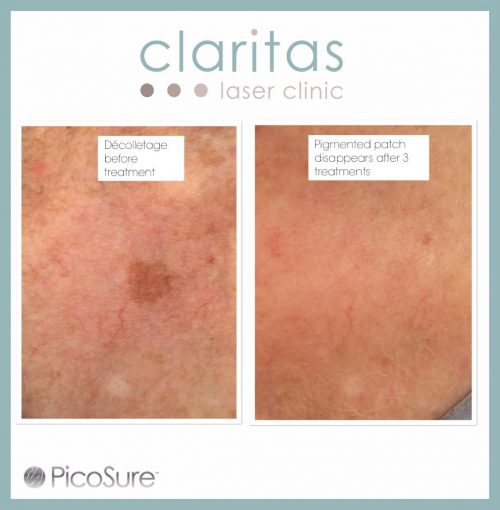
Pat, at 70 years young, had stopped wearing scoop-necked tops due to the unsightly pigmented area on her décolletage (shown here).
After just three treatments with the PicoSure laser, each taking just a few minutes, the lesion had completely disappeared.
Don’t waste time and money on ‘lightening creams’. Come and have a chat with us to discuss whether laser treatment might be a much more effective treatment for your age spots or other pigmentation problems. We can treat the face and hands as well as the body.
Make the most of our clinical knowledge to assess pigmentation changes from a medical as well as an aesthetic perspective. We will make a diagnosis and make sure you receive the correct management and treatment.
Call us today on 01480 214442 or email us on info@claritaslaserclinic.co.uk
Where does Tattooing come from? A little bit of history for you
December 6th, 2017
 Did you know? The word tattoo, or tattow in the 18th century, is a word that comes from the Polynesian word tatau, meaning ‘to write’.
Did you know? The word tattoo, or tattow in the 18th century, is a word that comes from the Polynesian word tatau, meaning ‘to write’.
Before the use of the Polynesian word, the practice of tattooing had been described in the West as painting, scarring, or staining.
Tattooing has been practiced across the globe since at least Neolithic times, as seen in mummified preserved skin, ancient art and records.
It was thought that many of the Anglo-Saxon kings of England were tattooed but much of this was conjecture. Reliable reports of tattooing date from the period of increased contact with non-European cultures.
(Our thanks to Wikipedia for the brief history lesson).
When a replacement tattoo is so much better than a cover-up
November 8th, 2017
Michelle, 38, loves tattoos but hated the red and green rose she had done on her thigh 30 years ago. She was embarrassed by the awful artwork and felt it affected her self-esteem.
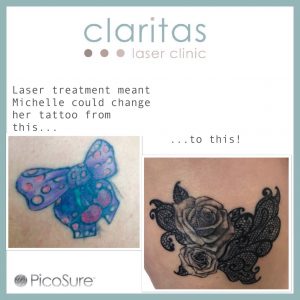 Like so many people, she thought a quick cover up would be the answer and, 10 years ago, she got the bow and cherries done over the rose. “But because of the tattoo beneath, it never looked quite right,” says Michelle, “and even a further touch up didn’t help.”
Like so many people, she thought a quick cover up would be the answer and, 10 years ago, she got the bow and cherries done over the rose. “But because of the tattoo beneath, it never looked quite right,” says Michelle, “and even a further touch up didn’t help.”
Michelle had been considering laser tattoo removal for about four years but had been put off by fears about the pain and the cost. Finally, having decided it was time to address the problem, Michelle came to us at Claritas, unsure if the bright colours could be removed and telling us how she really longed for an intricately patterned, filigree black tattoo.
We explained that using the Picosure lasers 755nm and 532nm wavelengths, we could significantly fade the colours, but that patience would be needed to achieve a clean canvas for such a detailed replacement design. We spoke about pain management and reassured her that she would be made as comfortable as possible.
Two years later, Michelle is delighted with her final tattoo and looks back on her journey, “I never thought it would fade as much as it did! The first couple of treatments were a bit painful but the staff were really caring and it’s over very quickly. Going to the clinic once every two months was certainly manageable in terms of cost. It was definitely worth it!”
We do love happy endings. If you have an ending that needs to be happy, then click here and find out more about our tattoo removals.
New! Vouchers for presents | Make someone happy
November 6th, 2017
Now you can treat someone special to any treatment and make a happy difference to their day. Perfect for Christmas surprises!
Y ou can buy Claritas gift vouchers in any denomination from our Clinic at 23a Huntingdon Street, St Neots, Cambridgeshire, PE19 1BG.
ou can buy Claritas gift vouchers in any denomination from our Clinic at 23a Huntingdon Street, St Neots, Cambridgeshire, PE19 1BG.
OR
You can buy gift vouchers over the phone by calling 01480 214442 and we will post them to any UK postcode FREE of charge.
OR
Unsure what to buy? Call or email us and we’ll happily advise you so you get it just right.
‘Kick-start’ your skin this autumn
October 10th, 2017
Sometimes Mother Nature needs a bit of a helping hand when it comes to giving your skin a ‘kick-start’. It happends naturally to us all and as we age, our skin loses its youthful tones and elasticity.

Help is at hand. By using pulses of laser light that reach deeply into the skin, the body’s natural healing process sweeps away older, damaged tissue and rebuilds it with fresh, new collagen and elastin- the crucial building blocks for smooth, youthful skin. Magic! (well not really, we know it’s all about the science). You’re rejuvenated.
Book for your free consultation and we’ll explain how a rejuvenated look can be yours.
Discover more here or contact us today.
Sun exposure; how does it affect laser treatment?
August 11th, 2017
 OK it hasn’t been the best of summers so far but that sunshine can still make an appearance. Or you might be off to warmer climes.
OK it hasn’t been the best of summers so far but that sunshine can still make an appearance. Or you might be off to warmer climes.
So here’s a low down on how the sun can affect laser treatments.
UVA and UVB rays in sunlight and the rays emitted by the laser are all light energy within the electromagnetic spectrum, albeit on different wavelengths.
Laser Tattoo Removal
It is really important to keep any sun exposure to your tattoo to the ABSOLUTE minimum. If at all possible, cover the tattoo with a dressing – easier if the tattoo is only small. If it’s larger, you may have to choose to wear clothing that covers the tattoo during the day. If your tattoo is too large to cover and you plan to be on the beach or by the poolside, then regular application of a waterproof sunblock of SPF 50 is recommended.
When the UV rays hit the skin, the production of melanin pigment is stimulated and this is what turns the skin brown. When the PicoSure laser is used to remove a tattoo, the ink should be the target and not the melanin pigment in your skin. If you are tanned, your laser treatment will be less effective at removing the tattoo. In addition, there is an increased risk of burning and blistering after treatment and also long term changes in the level of pigmentation in the treated skin.
Our team takes safety very seriously. If you have exposed your tattoo to the sun, we will not be able to perform a laser tattoo removal treatment for four weeks. We would also recommend that you wait four weeks after a treatment before going in the sun. This means that if you are mid-way through a course of laser tattoo removal you need to give careful consideration to how you are going to COMPLETELY AVOID sun exposure this summer.
Trust us, it will be worth the effort and there will be so many summers in the future for you to enjoy without your unwanted tattoo!
Laser Hair Removal
The Soprano Ice laser that we use is one of the few lasers that can quite safely be used on suntanned skin. However, if you are undergoing laser hair removal we do ask you to wait two weeks after sun exposure before having a treatment. You should have tanned sensibly using a suitable SPF factor; sunburn of the area to be treated needs special consideration.
With regard, to planning your treatment session before a holiday, it is best to leave it two weeks after a treatment before going in the sun. Sun exposure too soon after a treatment might lead to PIH (post-inflammatory hyper-pigmentation), where the skin develops irregular dark patches.
So what precautions should you take? If you are having treatment on your face then ideally you should be wearing a face cream or make-up with at least SPF 30 EVERY DAY. Ask us as we stock Vitage Skin Defence SPF30, which offers high protection from harmful UVA and UVB rays.
Here’s the technical but good-to-know bit…
Enriched with anti-inflammatory PhytoTerra Organic Mat and an Antioxidant-rich Rosamine Vitamin cocktail, Skin Defence SPF30 reduces the effects of daily sun damage and allows the skin to fight against environmental aggressors. Infused with Sodium Hyaluronate and Aloe Vera, it provides excellent skin protection and hydration and leaves the skin feeling lusciously soft, soothed and deeply hydrated. The lightweight, silky formula is suitable for all skin types and can be used daily for year-round protection.
Handy hint: Skin Defence SPF30 is ideal for outdoor pursuits and sports too.
The two-week rule (no unprotected sun exposure for two weeks before or after laser treatment) is very important for the face and most body areas, with the exception of the underarms – it is quite difficult to expose your armpits to the sun!
What about fake tan?
Absolutely fine to use and much better for your skin than potentially harmful and ageing UVB rays but, again, do stick to the two-week rule!
Got any questions or looking for some friendly advice? Call us on 01480 214442 or email info@claritaslaserclinic.co.uk
Tattoo removal and pain – the true facts
July 18th, 2017
Those ‘first-love’ feelings that go with getting a tattoo include pleasure and a connection with the image that’s now a part of your skin.
However, at some point, this decision could lead to regret and even despair.
Perhaps you’ve changed how you feel about your tattoo as you’ve grown up. Or maybe the subject of your tattoo is no longer relevant. Or it’s just that the artwork was never quite right.
If this is you, you are not alone! A study by YouGov (July 2015) suggests that almost 1 in 5 people are unhappy with at least one of their tattoos.

Now you can do something about that tattoo you regret. If you’ve done your research, you’ll realise that the best way to remove tattoo ink, without the risk of permanent scarring, is with laser treatment, which is why you’re here reading this.
For many, it is the fear of the pain. Now for some experienced reassurance…
There is no getting away from the fact that some pain is involved with tattoo removal. As technology has advanced, laser treatment has become much more tolerable and many of our clients liken the sensation to when their tattoo was first done. The BIG difference is that it is so much faster! Clients who have been treated with older lasers, for instance Q-switched, and then PicoSure notice the positive difference with this contemporary technology.
For example, a small tattoo of 3cm square would take about a minute to treat.
Throughout the process an ultra-cold air jet cools and numbs the skin. This counteracts the heat of the laser and helps protect the skin whilst the laser targets the ink. Contrary to some people’s mistaken belief, the tattoo is not ‘burned off’.
If even a minute of pain seems unbearable, or your tattoo is larger, then there are numbing creams that can be applied to the skin 30 minutes before treatment – these reduce rather than eliminate discomfort. Alternatively, for complete pain elimination, you can have injections of local anaesthetic. We are fully trained in all of this.
Hopefully, this has helped to calm any concerns you have but the best reassurance will come from talking through your situation with one of our team here at Claritas Laser Clinic. We are experienced, professional and kind and, importantly, understand how you might be feeling and quickly put you at ease.
Your first consultation is free so you can see how clinic, see how we work and then make your decision.
Call 01480 214442 for a free consultation or book on-line here and take that step today.
Amy’s engagement sees tattoo fade away
May 24th, 2017
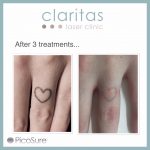 Amy is delighted by how quickly her tattoo is fading. The great thing is that she has found the treatments both quick and so much more comfortable than she expected.
Amy is delighted by how quickly her tattoo is fading. The great thing is that she has found the treatments both quick and so much more comfortable than she expected.
Since starting her treatment, Amy has become engaged and so it means a lot to her to wear her new ring without a past memory detracting from it.
Big congratulations from the team, Sally and Melanie!
Age spots and pigmented marks? | Here’s how to remove them
April 21st, 2017
Do you feel self-conscious about age spots and brown marks caused by sun damage? Are they adding years to your appearance? Then laser treatment could be the solution.
Don’t just take our word for it. Take Pat’s word for it…

Pat, at 70 years young, had stopped wearing scoop-necked tops due to the unsightly pigmented area on her décolletage (shown here).
After just three treatments with our PicoSure laser, each taking just a few minutes, the lesion had completely disappeared.
‘Lightening creams’ can waste your time and, more importantly, your money. Instead come and have a chat with us to discuss whether laser treatment could be a much more effective treatment for your age spots or other pigmentation problems. We can treat the face and hands as well as the body.
Make the most of our clinical knowledge to assess pigmentation changes from a medical as well as an aesthetic perspective. We will make a diagnosis and make sure you receive the correct management and treatment with a friendly welcome.
Call us today on 01480 21442 or email us on info@claritaslaserclinic.co.uk
Red tattoo gone after 6 treatments
April 3rd, 2017
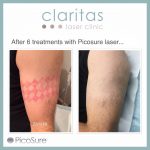 Chris is delighted that his red tattoo has finally disappeared – it was done almost 30 years ago.
Chris is delighted that his red tattoo has finally disappeared – it was done almost 30 years ago.
He had undergone numerous treatments with a Nd-Yag laser without seeing much fading. He did his research and realised the Picosure laser would give him the best chance of finally losing the red ink that was proving so stubborn.
Despite the journey to Claritas taking two hours each way, Chris certainly feels it was worth it as, after just six treatments, the red ink is almost undetectable.
We’re delighted with the results too!
Ingrowing hairs? Be gone!
March 28th, 2017
If you are one of the unlucky few who develop ingrown hairs, life can be pretty miserable.
The skin around these hairs can swell to the size of a hazelnut and there’s often redness and tenderness, which can be really painful, never mind unsightly!
However, help is at hand as laser treatment is recommended by dermatologists as the best way to prevent ingrown hairs.

Ingrown and normal hair
So why do we get ingrown hairs? It happens when a new hair curls in on itself as it grows and the hair becomes trapped in the follicle. Cutting or shaving the hair too closely makes it easier for the sharpened end of the hair to pierce the skin and grow inwards.
Inflammation causes redness and localised swelling and, if infection sets in, then a pus-filled cyst can develop. Infection is usually due to staphylococcal bacteria entering the follicle and both shaving and waxing can be the causes.
Where do they most frequently occur? Ingrown hairs are most common in areas where hair is coarse or curly or with frequent shaving; in men, on their chin and neck (causing razor or shaving bumps) and on their backs and in women, in the pubic area, along the bikini line or the underarms.
If you’re prone to this, then Laser Treatment is the hair removal method of choice as the laser energy targets the hair follicle to prevent new hair growth.
Talk to us for free friendly advice!
Laser hair removal on suntanned skin? Well yes and no. Read on…
March 21st, 2017
Laser Hair Removal
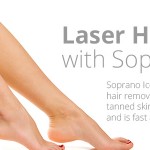 The Soprano Ice laser we use is one of the few lasers that can quite safely be used on suntanned skin. However, if you are undergoing laser hair removal we ask you to wait two weeks after sun exposure before having a treatment. You should have tanned sensibly using a suitable SPF factor; sunburn of the area to be treated needs special consideration.
The Soprano Ice laser we use is one of the few lasers that can quite safely be used on suntanned skin. However, if you are undergoing laser hair removal we ask you to wait two weeks after sun exposure before having a treatment. You should have tanned sensibly using a suitable SPF factor; sunburn of the area to be treated needs special consideration.
With regard, to planning your treatment session before a holiday, it is best to leave it two weeks after a treatment before going in the sun. Sun exposure too soon after a treatment might lead to PIH (post-inflammatory hyper-pigmentation), where the skin develops irregular dark patches.
So what precautions should you take? If you are having treatment on your face then ideally you should be wearing a face cream or make-up with at least SPF 30 EVERY DAY. Ask us as we stock Vitage Skin Defence SPF30, which offers high protection from harmful UVA and UVB rays.
Here’s the technical bit…
Enriched with anti-inflammatory PhytoTerra Organic Mat and an Antioxidant-rich Rosamine Vitamin cocktail, Skin Defence SPF30 reduces the effects of daily sun damage and allows the skin to fight against environmental aggressors. Infused with Sodium Hyaluronate and Aloe Vera, it provides excellent skin protection and hydration and leaves the skin feeling lusciously soft, soothed and deeply hydrated. The lightweight, silky formula is suitable for all skin types and can be used daily for year-round protection.
Handy hint: Skin Defence SPF30 is ideal for outdoor pursuits and sports too.
The two-week rule (no unprotected sun exposure for two weeks before or after laser treatment) is very important for the face and most body areas, with the exception of the underarms – it is quite difficult to expose your armpits to the sun but just in case!
What about fake tan?
Absolutely fine to use and much better for your skin than potentially harmful and ageing UVB rays but, again, do stick to the two-week rule!
Got any questions or looking for some friendly advice? Call us on 01480 214442 or email on info@claritaslaserclinic.co.uk
Plan ahead for the summer! Read how sun exposure affects laser tattoo removal
March 15th, 2017
Summer is a promise around the corner and here’s to some sunny days ahead. It’s also a popular time to travel to foreign climes and enjoy a happy holiday.
(Scientific bit coming up). Did you know that UVA and UVB rays in sunlight and the rays emitted by the laser are all light energy within the electromagnetic spectrum, albeit on different wavelengths.
So what is the affect of sun exposure if you are planning laser tattoo treatment or are mid-way through a treatment course? Read on…
Laser Tattoo Removal
It’s really important to keep any sun exposure to your tattoo to the ABSOLUTE minimum. If at all possible cover the tattoo with a dressing – easier if the tattoo is only small. If it’s larger you may have to choose to wear clothing that covers the tattoo during the day. If your tattoo is too large to cover and you plan to be on the beach or by the poolside, then regular application of a waterproof sunblock of SPF 50 is recommended.
When the UV rays hit the skin, the production of melanin pigment is stimulated and this is what turns the skin brown. When the PicoSure laser is used to remove a tattoo, the ink should be the target and not the melanin pigment in your skin. If you are tanned, your laser treatment will be less effective at removing the tattoo. In addition, there is an increased risk of burning and blistering after treatment and also long term changes in the level of pigmentation in the treated skin.
Our team takes safety very seriously. If you have exposed your tattoo to the sun, we will not be able to perform a laser tattoo removal treatment for four weeks. We would also recommend that you wait for four weeks after a treatment before going in the sun. This means that if you are mid-way through a course of laser tattoo removal you need to give careful consideration to how you are going to COMPLETELY AVOID sun exposure this summer.
Trust us, it will be worth the effort and there will be so many summers in the future for you to enjoy without your unwanted tattoo!
Got any questions or looking for some friendly advice? Call us on 01480 214442 or email on info@claritaslaserclinic.co.uk
Help is right here for Polycystic Ovary Syndome (PCOS)
March 3rd, 2017
Harnaam Kaur, who has Polycystic Ovary Syndome, was featured last week on BBC2’s Incredible Medicine: Dr Weston’s Casebook.
Kaur, who has Polycystic Ovary Syndome, was featured last week on BBC2’s Incredible Medicine: Dr Weston’s Casebook.
PCOS causes male-pattern facial hair growth in women. Harnaam proudly chooses to wear her beard and says, “I live by the phrase ‘My body, my rules’. If keeping your hair makes you uncomfortable or depressed, then get rid of it; otherwise, if you’ve got it, rock it.”
Laser Hair Removal is available for women with PCOS who choose not to rock it.
Call us at any time and we will happily advise on how it works and the best path for you.
Victor is a happy man and wants to share his photo – here’s why
March 2nd, 2017
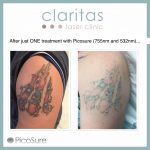 Victor is delighted with the amount of ink cleared after just ONE treatment with the Picosure.
Victor is delighted with the amount of ink cleared after just ONE treatment with the Picosure.
He was keen that his photos were posted for others to see, as he found visual information to be very helpful when he did his reasearch prior to starting the tattoo removal process.
Thanks for sharing Victor and thanks for the helpful feedback.
Which is the best tattoo removal method?
February 16th, 2017
How to remove a tattoo and why laser tattoo removal is best
Many of us are having tattoos now, in fact almost a third of people have a tattoo by the age of 18. Sadly though, one in six people in the UK will regret having it done. A third of those with tattoos worry that they will look awful as they get older. And half of those people admit that the tattoo could hold them back in their careers.
So what can be done?
There are many options available for tattoo removal. Unfortunately though some of these techniques are not safe at all and can cause permanent scarring. It’s important when considering tattoo removal to know exactly where in your skin the tattoo exists. The diagram below of skin shows the tattoo particles lying underneath the healthy outer epidermis. So tattoo removal needs to be effective without damaging the outer layer of your skin.
Some of the different methods of tattoo removal available today.
Tip: Keep reading right to the bottom…
1. Micro dermabrasion
Micro dermabrasion involves using an abrasive device to sand down the layers of the skin. This will be incredibly painful and will result in an open wound that will have to heal. There are obviously going to be many complications of such a treatment which include pain, infection, burning, itching, scabbing, scarring, bleeding and many more.
2. Salabrasion
Salabrasion is similar to microdermabrasion, but instead of using an abrasive brush or a diamond wheel, granular salt and water are used. These are blasted onto the skin with force, resulting in the stripping away of the outer layers of the skin. This technique is repeated every few days until the scarred tissue pulls away supposedly leaving healthy tissue underneath taking the tattoo with it. Yet again there are many negative side effects of this treatment and ultimately will result in very bad scarring.
3. Surgical excision
Surgical excision of a tattoo involves using a surgical knife to cut away the tattoo. This will performed under local anaesthetic injections. It can only be done if the skin can compensate for the area where the tattoo has been removed – this means can the skin be repaired? Large tattoos will require skin grafts and need multiple visits if the skin cannot be simply stitched together. The after effects of surgical excision include pain, swelling, bruising, postoperative infection and bruising.
4. Acid
Acid contained within certain lotions and creams can be applied to the tattooed skin to remove the ink. Unfortunately, it is not as simple as that. The ink particles of the tattoo sit within the mid layer of the skin, and so the acid has to burn off the outer layer of the skin before even reaching the ink. According to clinical dermatologists in the UK, anything that burns off the skin just wont work and will lead to many more complications. Many products bought over the internet contain trichloroacetic acid which is a corrosive chemical, and is actually a banned ingredient resulting in horrific burns.
5. Tattoo removal creams
Similar again to acid removal, these creams will contain corrosive substances that will claim to fade your tattoo. As the ink lies in the middle layer of the skin, such creams will never be able to reach the tattoo pigment and will only likely result in irritated and inflamed skin that could actually result in scarring.
6. Rejuvi and other injectable methods
Rejuvi involves having a chemical remover applied to the skin, similar to having a tattoo in the first instance. Rejuvi claims to ‘capture’ the ink particles by forming a thicker substance within the dermis and then pushing out through the outer layer of the skin along with the trapped ink particles. It all sounds very simple, but sadly it is not and has resulted in really severe scarring.
7. Cryotherapy
Cryotherapy involves in having the tattooed skin frozen off. Yet again though, this involves taking away the healthy unaffected outer layer of skin to reach the pigmented dermal layer. Sometimes cryotherapy can be combined with microdermasion, so the results of such treatment not surprisingly result in really bad scarring, severe pain, swelling, blistering and scabbing. post operative infection is highly likely.
And last but by no means least – laser tattoo removal.
The safest and most effective method for tattoo removal available today.
8.Laser Tattoo Removal
Laser tattoo removal is the only safe and effective method to remove a tattoo without damaging the outer layer of the skin. Laser light energy penetrates the skin to reach the tattoo pigments. Different wavelengths of light will target different tattoo colours. The amount of energy delivered must be sufficient to break up the ink. Older lasers would do this in nanoseconds, and the resultant heat will fragment the heat. Too much heat will result in damage to the surrounding skin. Fortunately today we have Picosure and it’s world leading picosecond technology. The pulse duration, ie the speed, is so fast it breaks up the ink photo-mechanically rather than heating the ink. The integrity of the outer dermis of the skin is maintained and undamaged.
Tattoo removal; explaining away the (much reduced) pain
February 3rd, 2017
The initial feelings that accompany getting a tattoo include pleasure, independence and a deep connection with what is depicted on your skin.
However, in the shorter or longer term, this important decision may lead to regret and even despair.
Perhaps you’ve changed how you feel about your tattoo. Perhaps the subject of your tattoo is no longer relevant. Or maybe the artwork was never quite right.
If this applies to you, you are not alone! A study by YouGov suggested that almost 1 in 5 people are unhappy with at least one of their tattoos.

So do something about that tattoo you regret. You’ve done your research and realise that the best way to remove tattoo ink, without the risk of permanent scarring, is with laser treatment, which is why you’re reading this.
For many people, it is the fear of the pain.
Read on for some reassurance…Unfortunately, there is no getting away from the fact that some pain is involved with tattoo removal. As technology has advanced, laser treatment has become much more tolerable and many of our clients liken the sensation to when their tattoo was first done. The BIG difference is that it is SO much faster!
Clients who have been treated with older lasers, for instance Q-switched, and then PicoSure notice the positive difference.
For example, a small tattoo, of 3cm square, would take about a minute to treat.
Throughout the process, an ultra-cold air jet cools and numbs the skin. This counteracts the heat of the laser and helps protect the skin whilst the laser targets the ink. Contrary to some people’s mistaken belief, the tattoo is not ‘burned off’!
If even a minute of pain seems unbearable, or your tattoo is larger, then there are numbing creams that can be applied to the skin 30 minutes before treatment – these reduce rather than eliminate discomfort. Alternatively, for complete pain elimination, you can have injections of local anaesthetic.
Hopefully, this has helped calm any concerns you may be having but the best reassurance will come from talking through your individual situation with one of our team of clinicians. We are experienced, professional and kind and, importantly, understand how you might be feeling and very quickly put you at ease.
Call 01480 214442 for a free consultation or book on-line here and take that step today.
We love to share on Facebook
January 27th, 2017
 In case you didn’t know, we’re on Facebook!
In case you didn’t know, we’re on Facebook!
We love to share our news with you so do join us.
Here we are in the Hunts Post the other week.
Another year on | Age spots and how to remove them
January 12th, 2017
Do you feel self-conscious about age spots and brown marks, such as solar lentigos caused by sun damage, and feel they are adding years to your appearance? Then laser treatment could be the solution.
Don’t just take our word for it. Take Pat’s word for it…

Pat, at 70 years young, had stopped wearing scoop-necked tops due to the unsightly pigmented area on her décolletage (shown here).
After just three treatments with the PicoSure laser, each taking just a few minutes, the lesion had completely disappeared.
Don’t waste time and money on ‘lightening creams’. Instead come and have a chat with us to discuss whether laser treatment might be a much more effective treatment for your age spots or other pigmentation problems. We can treat the face and hands as well as the body.
Make the most of our clinical knowledge to assess pigmentation changes from a medical as well as an aesthetic perspective. We will make a diagnosis and make sure you receive the correct management and treatment.
Call us today on 01480 214442 or email us on info@claritaslaserclinic.co.uk
Out with the old, in with the new (skin)
January 2nd, 2017
Want to explore a new look for 2017?
It’s the start of a new year and time to give Mother Nature a bit of a helping hand when it comes to skin rejuvenation. As we age, our skin, naturally, loses its youthful tones and tautness.

We can help. By using pulses of laser light that reach deeply into the skin, the body’s natural healing process sweeps away older, damaged tissue and rebuilds it with fresh, new collagen and elastin—the crucial building blocks of smooth, youthful skin. Presto! You’re rejuvenated.
We’ll give you a free consultation and explain how rejuvenated skin can be yours this year.
Discover more here or contact us today.
Laser Tattoo Removal – things you need to know
December 16th, 2016
It may be easy to forget about that tattoo when it’s hidden under your woollies, but if you are wanting to lose it for the long-term, or would like to fade it for a cover-up, then read on…
5 things to consider  before undergoing treatment:
before undergoing treatment:
1. You’ll need more than one treatment.
Tattoo removal is a gradual process and multiple treatments are required. Unfortunately, it is very difficult to predict the number of sessions needed as inks vary enormously as do individual immune systems. The laser breaks up the ink particles but then it’s the immune system that clears the ink away and this takes time. There is no benefit to lasering the tattoo any more often than once every eight weeks – it just needs TIME.
2. Where is your tattoo?
The location of your tattoo does make a difference. Tattoos on the upper body and neck will tend to fade faster than those on hands and feet. This is because the blood supply and lymphatic drainage to and from these areas is better, helping your immune system carry away those unwanted ink particles faster.
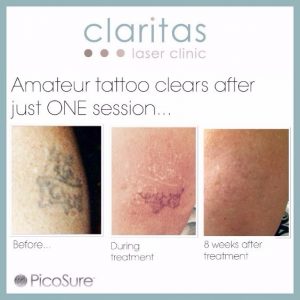 3. Is it a professional or amateur job?
3. Is it a professional or amateur job?
Generally, a professional tattoo artist will deliver the ink at many depths to build density of colour and this means more sessions are likely to be needed in order to target the different layers of ink. Usually, amateur tattoos, delivered with an uneven hand are easier to remove. The tattoo pictured opposite seem to literally diappear before our eyes, but usually te fading is more of a gradual process.
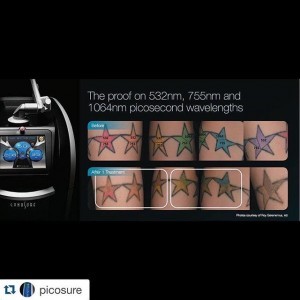 4. What colours are in your tattoo?
4. What colours are in your tattoo?
Traditionally, no one laser could treat all ink colours. However, the Picosure has changed that! Its standard 755nm handpiece is fantastic on the blues and greens that Q-switched lasers can’t fragment. And, of course, it treats black. There is also the option of using a 532nm handpiece on the Picosure (which we have right here!) and this targets red, oranges and yellow inks. We can literally treat the rainbow of colours.
5. You, wonderful you!
How healthy are you? Could you be doing more to help boost your immune system? If you are embarking on tattoo removal, give your body all the help you can by eating healthily, maintaining hydration, keeping down your alcohol consumption, exercising and getting enough sleep. It won’t come as a surprise to hear that, as a rule, smokers clear their ink more slowly than non-smokers.
Laser Hair Removal – smooth legs by summertime
December 12th, 2016
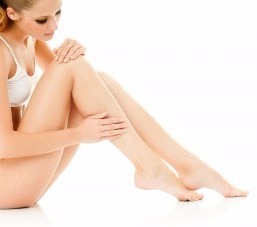 You could have smooth legs by next summer or underarms that you can forget all about.
You could have smooth legs by next summer or underarms that you can forget all about.
Look forward to a permanent reduction in hair growth by starting your laser treatment now. Waxing, epilating and hair removal creams are a no-no once you start the process, although shaving is absolutely fine and is indeed recommended the day before a laser session.
You typically have eight sessions initially and are seen once every four to six weeks.
If you are lucky enough to have some winter sun booked, don’t worry, we can still treat suntanned skin – you’ll just have to wait two weeks after you get home before your next session.
From hairy to smooth! Happy results after just 6 Soprano Ice laser treatments
November 9th, 2016
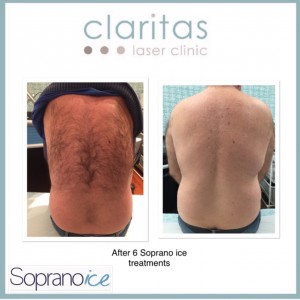 Unwanted back hair can be a real cause of misery and embarrassment for many men. Summer holidays can be spent covered up under shirts to avoid showing a hairy back.
Unwanted back hair can be a real cause of misery and embarrassment for many men. Summer holidays can be spent covered up under shirts to avoid showing a hairy back.
Treatments up to now for back hair such as waxing can be painful, costly and very time consuming. With laser hair removal, a simple course of 6 – 8 pain free laser treatments every 4 – 6 weeks with us can achieve amazing results.
These photos of our client prove just that. He has reached an amazing result after just six treatments and is looking forward to next summer with delight.
Now is the time to consider laser hair removal; treat yourself or your partner to a clear back at Claritas Laser Clinic!
Please contact the team if you would like more information or friendly advice on 01480 214442 or email us on info@claritaslaserclinic.co.uk
We’re in the news!
November 1st, 2016
We are really rather proud of our move to St Neots and the added space and design within the Clinic.
So we’re also really rather chuffed to be in The Hunts Post with an overview of what we offer, how we got here and why we’re a good choice for highly professional services from tattoo removal to skin rejuvenation to hair removal.
Want to read it? Click the image for the full article.
Popularity of tattoo removal and skin rejuvenation is why we moved!
October 25th, 2016
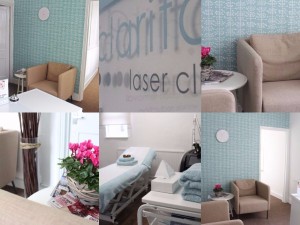 People who have seen remarkable results from tattoo removal to skin rejuvenation have happily enjoyed using our services and are even happier as they are ‘at nowhere near London prices’.
People who have seen remarkable results from tattoo removal to skin rejuvenation have happily enjoyed using our services and are even happier as they are ‘at nowhere near London prices’.
We are really delighted with our relocation and everyone is enjoying the additional space and comfort.
We’re equipped with the world’s most advanced array of cosmetic lasers for tattoo removal, skin rejuvenation and the most pain-free, effective hair removal laser yet.
Almost two years on and we’ve had many clients who have been so happy with our services that we often get word-of-mouth referrals. And there is no better testimony than that.
The PicoSure laser is the most technically sophisticated in the world with only a few throughout the UK and most being in London. Hence why clients travel to Claritas from as far afield as Derbyshire, Oxfordshire and London.
“The training in the use of these lasers is paramount and, whilst in the USA these treatments are strictly regulated, we aim to bring that same level of expertise to the UK for the first time,” explains Melanie. “People must be confident when they are choosing this type of treatment and do their research to make sure the results they end up with are what they wanted.”
Along with the PicoSure laser, the Soprano Ice effectively removes hair from all skin types and should not be confused with IPL (Intense Pulsed Light) which is not a true laser and is less effective. Hair removal is popular with both men and women and remarkable results are usually reached in just six to eight treatments.
As the trend for tattoos grows and more and more celebrities choose to adorn their bodies with artwork, so too has the trend to have tattoos removed increased. “Often someone has had a tattoo done in a partner’s name who becomes an ex-partner and they want to return to a blank skin canvass”, says Sally. “Or it could be they are tired of an existing tattoo and want to remove it in order to have a fresh design done. In either case, our laser treatment gives a clean, fast, effective and relatively painless result.”
Either way the team at Claritas can help. Pop in to see us at our new clinic at 23a Huntingdon Street, St Neots.
We have moved!
September 21st, 2016
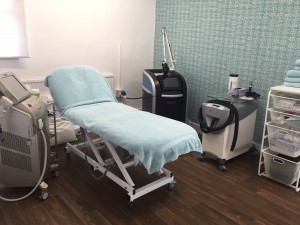 And we’re in! Just as anyone who has moved will know, things don’t always go to time plan. So we’re all sorted inside with the clinic looking really good.
And we’re in! Just as anyone who has moved will know, things don’t always go to time plan. So we’re all sorted inside with the clinic looking really good.
We just need to sort the outside so please don’t be put off by the front door. It’s next on the check list!
We can’t wait to welcome you and show you around. Feeling rather chuffed.
We are moving!
September 12th, 2016
We’re on the move! But not too far away. We’re leaving Buckden and moving to St Neots.
From Tuesday 20th September, Claritas Laser Clinic will be happily residing in newly renovated, bigger and better premises in St Neots, just five miles south of where we currently are.
We will still be working as usual in Buckden, up to and including Saturday 17th September.
Our new clinic is easy to access and located right beside two large pay and display car parks in the attractive market town of St Neots. Road links are so easy as we’re close to the A1 and not far from the A14.
You will find the entrance on Tebbutts Road where our door is nestled between the dental surgery, ‘my dentist’, and the hairdressers, ‘Gossip’.
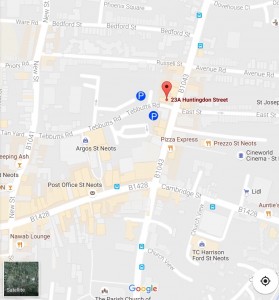 Our new address is:
Our new address is:
23a Huntingdon Street
St Neots
Cambridgeshire
PE19 1BG
01480 214442
For a few weeks we will be adding the finishing touches so do bear with us but rest assured our Clinic Room will be fully functional and ready to welcome you from Tuesday 20th September.
Best wishes and we look forward to seeing you at our new clinic
Sally and Melanie
Fancy eight free tattoo removal treatments worth up to £1000? Be on TV and it could be yours!
August 3rd, 2016
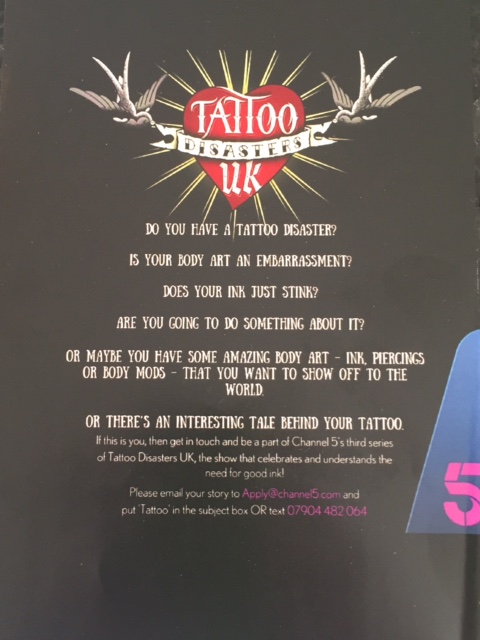 You could be enjoying eight FREE treatments to have your tattoo removed, worth up to £1000!
You could be enjoying eight FREE treatments to have your tattoo removed, worth up to £1000!
We’re looking for people who would be willing to take part in a Channel 5 TV series called ‘Tattoo Disasters UK’.
Is your body art an embarrassment? It could be an ex’s name, a holiday mistake or a misspelled mishap. Or do you have an interesting tale behind your tattoo?
If so then please get in touch with us as we are working with Channel 5 who are keen to meet people with a story to tell about their tattoo.
The successful applicant who features on the show will ‘win’ eight free treatments from us to have the tattoo removed.
Please contact us on 01480 272472 or email info@claritaslaserclinic.co.uk as soon as possible as the series starts filming soon.
We are looking for people with tattoo disasters for Channel 5 TV programme
August 3rd, 2016
 Can you help? We’re looking for people who would be willing to take part in a Channel 5 TV series called ‘Tattoo Disasters UK’.
Can you help? We’re looking for people who would be willing to take part in a Channel 5 TV series called ‘Tattoo Disasters UK’.
Do you have a tattoo disaster? Is your body art an embarrassment? It could be an ex’s name, a holiday mistake or a misspelled mishap. Or do you have an interesting tale behind your tattoo?
If so then please get in touch with us as we are working with Channel 5 who are keen to meet people with a story to tell about their tattoo.
And if you are looking to have the tattoo removed then we are offering eight free treatments, worth up to £1000, to the successful applicant who features on the show.
Please contact us on 01480 272472 or email info@claritaslaserclinic.co.uk as soon as possible as the series starts filming soon.
Rebecca’s delight as tattoo disappears
July 4th, 2016
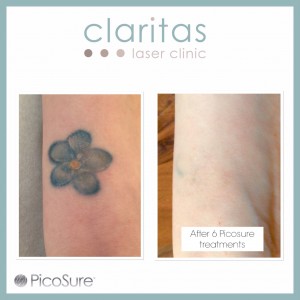 “The treatment and service I received at Claritas Laser Clinic for my tattoo removal was excellent. The Picosure treatments removed the tattoo and I was very happy with the end result. Would definitely recommend the clinic and procedure”.
“The treatment and service I received at Claritas Laser Clinic for my tattoo removal was excellent. The Picosure treatments removed the tattoo and I was very happy with the end result. Would definitely recommend the clinic and procedure”.
Rebecca | July 2016
Age spots and pigmented lesions – how to remove them
June 10th, 2016
Do you feel self-conscious about age spots and brown marks, such as solar lentigos caused by sun damage, and feel they are adding years to your appearance? Then laser treatment could be the solution.
Don’t just take our word for it. Take Pat’s word for it…

Pat, at 70 years young, had stopped wearing scoop-necked tops due to the unsightly pigmented area on her décolletage (shown here).
After just three treatments with the PicoSure laser, each taking just a few minutes, the lesion had completely disappeared.
Don’t waste time and money on ‘lightening creams’. Instead come and have a chat with us to discuss whether laser treatment might be a much more effective treatment for your age spots or other pigmentation problems. We can treat the face and hands as well as the body.
Make the most of our clinical knowledge to assess pigmentation changes from a medical as well as an aesthetic perspective. We will make a diagnosis and make sure you receive the correct management and treatment.
Call us today on 01480 272472 or email us on info@claritaslaserclinic.co.uk
How does sun exposure affect laser treatment?
June 2nd, 2016

With summer fast approaching, we are all hoping that there will be some gloriously sunny days to enjoy. It’s also a popular time for families to travel to foreign climes and enjoy a well-deserved holiday.
Did you know? UVA and UVB rays in sunlight and the rays emitted by the laser are all light energy within the electromagnetic spectrum, albeit on different wavelengths.
So what is the significance of sun exposure if you are planning laser treatment or are mid-way through a treatment course? Read on…
Laser Tattoo Removal
It is really important to keep any sun exposure to your tattoo to the ABSOLUTE minimum. If at all possible, cover the tattoo with a dressing – easier if the tattoo is only small. If it’s larger, you may have to choose to wear clothing that covers the tattoo during the day. If your tattoo is too large to cover and you plan to be on the beach or by the poolside, then regular application of a waterproof sunblock of SPF 50 is recommended.
When the UV rays hit the skin, the production of melanin pigment is stimulated and this is what turns the skin brown. When the PicoSure laser is used to remove a tattoo, the ink should be the target and not the melanin pigment in your skin. If you are tanned, your laser treatment will be less effective at removing the tattoo. In addition, there is an increased risk of burning and blistering after treatment and also long term changes in the level of pigmentation in the treated skin.
Our team takes safety very seriously. If you have exposed your tattoo to the sun, we will not be able to perform a laser tattoo removal treatment for four weeks. We would also recommend that you wait four weeks after a treatment before going in the sun. This means that if you are mid-way through a course of laser tattoo removal you need to give careful consideration to how you are going to COMPLETELY AVOID sun exposure this summer.
Trust us, it will be worth the effort and there will be so many summers in the future for you to enjoy without your unwanted tattoo!
Laser Hair Removal
The Soprano Ice laser that we use is one of the few lasers that can quite safely be used on suntanned skin. However, if you are undergoing laser hair removal we do ask you to wait two weeks after sun exposure before having a treatment. You should have tanned sensibly using a suitable SPF factor; sunburn of the area to be treated needs special consideration.
With regard, to planning your treatment session before a holiday, it is best to leave it two weeks after a treatment before going in the sun. Sun exposure too soon after a treatment might lead to PIH (post-inflammatory hyper-pigmentation), where the skin develops irregular dark patches.
So what precautions should you take? If you are having treatment on your face then ideally you should be wearing a face cream or make-up with at least SPF 30 EVERY DAY. Ask us as we stock Vitage Skin Defence SPF30, which offers high protection from harmful UVA and UVB rays.
Here’s the technical but good-to-know bit…
Enriched with anti-inflammatory PhytoTerra Organic Mat and an Antioxidant-rich Rosamine Vitamin cocktail, Skin Defence SPF30 reduces the effects of daily sun damage and allows the skin to fight against environmental aggressors. Infused with Sodium Hyaluronate and Aloe Vera, it provides excellent skin protection and hydration and leaves the skin feeling lusciously soft, soothed and deeply hydrated. The lightweight, silky formula is suitable for all skin types and can be used daily for year-round protection.
Handy hint: Skin Defence SPF30 is ideal for outdoor pursuits and sports too.
The two-week rule (no unprotected sun exposure for two weeks before or after laser treatment) is very important for the face and most body areas, with the exception of the underarms – it is quite difficult to expose your armpits to the sun!
What about fake tan?
Absolutely fine to use, and much better for your skin than potentially harmful and ageing UVB rays but, again, do stick to the two-week rule!
Got any questions or looking for some friendly advice? Call us on 01480 272472 or email on info@claritaslaserclinic.co.uk
Amazing results after just SIX Picosure treatments
May 4th, 2016
The proof, they say, is in the pudding! Or in this case, the reveal of an arm with little trace of a tattoo.

And we are so pleased with the progress so far.
After only six Picosure treatments this, what was a large tattoo, is almost gone.
Discover more about our laser tattoo removal here.
Tattoo removal and pain – Dispelling the myths
April 8th, 2016
The initial feelings that accompany getting a tattoo include pleasure, independence and a deep connection with what is depicted on your skin.
However, in the shorter or longer term, this important decision may eventually lead to regret and even despair.
Perhaps you’ve changed how you feel about your tattoo as you’ve grown up. Perhaps the subject of your tattoo is no longer relevant. Or maybe the artwork was never quite right.
If this applies to you, you certainly are not alone! A study by YouGov in July 2015 suggests that almost 1 in 5 people are unhappy with at least one of their tattoos.

So what’s stopping you from doing something about that tattoo you regret? You’ve done your research and realise that the best way to remove tattoo ink, without the risk of permanent scarring, is with laser treatment, which is why you’re here reading this.
In short, for many people, it is the fear of the pain. Read on for some reassurance…
Unfortunately, there is no getting away from the fact that some pain is involved with tattoo removal. As technology has advanced, laser treatment has become much more tolerable and many of our clients liken the sensation to when their tattoo was first placed. The BIG difference is that it is SO much faster!
Clients who have been treated with older lasers, for instance Q-switched, and then PicoSure notice the positive difference with this latest technology.
For example, a small tattoo, of 3cm square, would take about a minute to treat.
Throughout the process, an ultra-cold air jet cools and numbs the skin. This air counteracts the heat of the laser and helps protect the skin, whilst the laser targets the ink. Contrary to some people’s mistaken belief, the tattoo is not ‘burned off’!
If even a minute of pain seems unbearable, or your tattoo is larger, then there are numbing creams that can be applied to the skin 30 minutes before treatment – these reduce rather than eliminate discomfort. Alternatively, for complete pain elimination, you can have injections of local anaesthetic.
Hopefully, this information has helped calm any concerns you may be having, but the best reassurance will come from talking through your individual situation with one of our team of clinicians at Claritas Laser Clinic. They are experienced, professional and kind and, importantly, they understand how you might be feeling and very quickly put you at ease.
Call 01480 272472 for a free consultation or book on-line here and take that step today.
Spring into spring with some skin rejuvenation
March 25th, 2016
Support your skin and look and feel wonderful
Spring is here and even Mother Nature enjoys a bit of rejuvenation. As we age, we need a bit of support too.

How? We use pulses of laser light that reach deeply into the skin. Then the body’s natural healing process sweeps away older, damaged tissue and rebuilds it with fresh, new collagen and elastin—the crucial building blocks of smooth, youthful skin. Presto! You’re rejuvenated.
What is the difference between IPL and Laser Hair Removal? (and why Laser is your better choice)
February 16th, 2016
Many people wrongly believe IPL and Laser treatment to be the same thing. So we would like to explain how these two treatments differ and why you should choose Laser Hair Removal over IPL.
Firstly, it’s no wonder there is some confusion as there are some similarities. Both treatments have been available commercially since the mid-90s and both involve the production of light energy, which is absorbed into the pigment of the hairto change the nature of the hair follicle. This then results in reducing the hair growth.
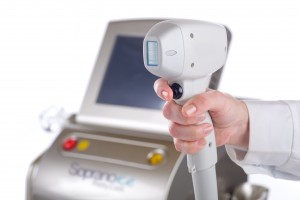
However, IPLs are NOT lasers. The IPL (Intense Pulsed Light) machine produces a broad spectrum of wavelengths (like a light bulb) and can’t be focused to a concentrated beam. The more shallow penetration, compared to laser, means that deeper, thicker hairs are not treated effectively. Additionally, with IPL, some of the light will be absorbed into the skin leading to a greater risk of skin burns, especially in darker skins.
Laser machines produce a single wavelength of light (pure light consisting of one single colour and form), which has a very concentrated beam and specifically targets the melanin in the hair follicle. Lasers are far more precise, and can selectively target dark, coarse hairs whilst leaving the surrounding skin undamaged. Laser settings can be adjusted to suit your specific skin tone and hair colour and, importantly, are safe for all skin colours.
Whilst IPL might be cheaper, it’s most certainly a less effective technology for reducing body hair.
Lose the misery of ingrown hair
January 20th, 2016
Are you prone to ingrown hairs? If you are one of the unlucky few who develop ingrown hairs, life can be really miserable.
The skin around these hairs can swell to the size of a hazelnut and there’s often redness and even pus – all of which can be intensely painful, never mind unsightly!
But did you know, laser treatment is recommended by dermatologists as the best way to prevent ingrown hairs.

Ingrown and normal hair
So why do we get ingrown hairs? They arise when a new hair curls in on itself as it grows and the hair becomes trapped in the follicle. Cutting or shaving the hair too closely makes it easier for the sharpened end of the hair to pierce the skin and grow inwards.
Inflammation causes redness and localised swelling and, if infection sets in, then a pus-filled cyst can develop. Infection is usually due to staphylococcal bacteria entering the follicle and both shaving and waxing facilitate this.
Where do they most frequently occur? Ingrown hairs are most common in areas where hair is coarse or curly or where frequent shaving occurs; in men, on their chin and neck (causing razor or shaving bumps) and on their backs and in women, in the pubic area, along the bikini line or in the underarms.
If you’re prone to this, then Laser Treatment is the hair removal method of choice as the laser energy targets the hair follicle to prevent new hair growth.
Methods of tattoo removal
December 15th, 2015
How to remove a tattoo and why laser tattoo removal is best
Many of us are having tattoos now, in fact almost a third of people have a tattoo by the age of 18. Sadly though, one in six people in the UK will regret having a tattoo. The third of those with tattoos worry that they will look awful as they get older. Half of those people admit that the tattoo could hold them back in their careers.
It’s a problem, so what can be done?
There are many options available for tattoo removal. Unfortunately though some of these techniques are not safe at all and can cause permanent scarring. It’s important when considering tattoo removal to know exactly where in your skin the tattoo exists. The diagram below of skin shows the tattoo particles lying underneath the healthy outer epidermis. So tattoo removal needs to be effective without damaging the outer layer of your skin.
Let’s have a look at some of the different methods of tattoo removal available today.
1. Micro dermabrasion
Micro dermabrasion involves using an abrasive device to sand down the layers of the skin. This will be incredibly painful and will result in an open wound that will have to heal. There are obviously going to be many complications of such a treatment which include pain, infection, burning, itching, scabbing, scarring, bleeding and many more.
2. Salabrasion
Salabrasion is similar to microdermabrasion, but instead of using an abrasive brush or a diamond wheel, granular salt and water are used. These are blasted onto the skin with force, resulting in the stripping away of the outer layers of the skin. This technique is repeated every few days until the scarred tissue pulls away supposedly leaving healthy tissue underneath taking the tattoo with it. Yet again there are many negative side effects of this treatment and ultimately will result in very bad scarring.
3. Surgical excision
Surgical excision of a tattoo involves using a surgical knife to cut away the tattoo. This will performed under local anaesthetic injections. It can only be done if the skin can compensate for the area where the tattoo has been removed – this means can the skin be repaired? Large tattoos will require skin grafts and need multiple visits if the skin cannot be simply stitched together. The after effects of surgical excision include pain, swelling, bruising, postoperative infection and bruising.
4. Acid
Acid contained within certain lotions and creams can be applied to the tattooed skin to remove the ink. Unfortunately, it is not as simple as that. The ink particles of the tattoo sit within the mid layer of the skin, and so the acid has to burn off the outer layer of the skin before even reaching the ink. According to clinical dermatologists in the UK, anything that burns off the skin just wont work and will lead to many more complications. Many products bought over the internet contain trichloroacetic acid which is a corrosive chemical, and is actually a banned ingredient resulting in horrific burns.
https://www.bbc.co.uk/news/uk-34368207
5. Tattoo removal creams
Similar again to acid removal, these creams will contain corrosive substances that will claim to fade your tattoo. As the ink lies in the middle layer of the skin, such creams will never be able to reach the tattoo pigment and will only likely result in irritated and inflamed skin that could actually result in scarring.
6. Rejuvi and other injectable methods
Rejuvi involves having a chemical remover applied to the skin, similar to having a tattoo in the first instance. Rejuvi claims to ‘capture’ the ink particles by forming a thicker substance within the dermis and then pushing out through the outer layer of the skin along with the trapped ink particles. It all sounds very simple, but sadly it is not and has resulted in really severe scarring.
7. Cryotherapy
Cryotherapy involves in having the tattooed skin frozen off. Yet again though, this involves taking away the healthy unaffected outer layer of skin to reach the pigmented dermal layer. Sometimes cryotherapy can be combined with microdermasion, so the results of such treatment not surprisingly result in really bad scarring, severe pain, swelling, blistering and scabbing. post operative infection is highly likely.
And finally, laser tattoo removal – The safest and most effective method for tattoo removal available today.
8.Laser Tattoo Removal
Laser tattoo removal is the only safe and effective method to remove a tattoo without damaging the outer layer of the skin. Laser light energy penetrates the skin to reach the tattoo pigments. Different wavelengths of light will target different tattoo colours. The amount of energy delivered must be sufficient to break up the ink. Older lasers would do this in nanoseconds, and the resultant heat will fragment the heat. Too much heat will result in damage to the surrounding skin. Fortunately today we have Picosure and it’s world leading picosecond technology. The pulse duration, ie the speed, is so fast it breaks up the ink photo-mechanically rather than heating the ink. The integrity of the outer dermis of the skin is maintained and undamaged.
Coming soon …..’how does laser tattoo removal work and why is the Picosure laser the most effective tattoo removal technology.’
New 532nm handpiece installed
September 2nd, 2015
 Claritas Laser Clinic has taken delivery of a new attachment for its PicoSure™ laser that will significantly improve its performance on tricky red, orange and yellow coloured tattoos.
Claritas Laser Clinic has taken delivery of a new attachment for its PicoSure™ laser that will significantly improve its performance on tricky red, orange and yellow coloured tattoos.
PicoSure™ lasers are the most technically sophisticated in the world and are so named because they use pico-second bursts of laser light to remove tattoos, treat acne scars and pigmentation or rejuvenate skin.
Existing PicoSure™ devices operate at 755nm wavelength, which is ideal for blue, green and black tattoo inks, however this upgrade allows the laser to also operate at 532nm wavelength – making it even more effective against stubborn yellows, oranges and reds.
“At Claritas we like to keep up with the very latest technology, so we can offer optimum results for our patients,” explains Melanie.
“PicoSure™ is the only laser system in the world that can offer these different forms of laser light to treat the full spectrum of coloured tattoos.”
Sally James added: “When introduced, the Picosure laser was the greatest advance in tattoo removal in 20 years. This upgrade offers yet another step-change improvement; and not only is the new laser more effective, but it also requires fewer treatments, making it far more cost effective for our clients.”
Claritas clinicians attend ASLMS 2015 in Florida
April 25th, 2015
The annual conference of the American Society of Lasers in Medicine and Surgery is an opportunity for the clinicians at Claritas to benefit from the expertise of America’s top Laser Dermatologists. Daily workshops and sessions are run to allow clinicians to share their experience and widen their knowledge to get the best possible results when performing laser treatments.
Official launch event for Claritas
March 24th, 2015
Yesterday, Claritas Laser Clinic held an open afternoon for anyone to drop in and see the clinic.It was a popular event, where people could informally meet the Claritas team, and ask questions about the many treatments on offer.
Last night Claritas opened it’s doors to local businesses and press for the Official Launch of the clinic. Directors Melanie Ando and Sally James were delighted to have Anne Furbank declare the clinic formally open. The evening proved a good opportunity to showcase the Picosure and Soprano Ice lasers, and the visitors left knowing more about the full potential of these world class lasers.

